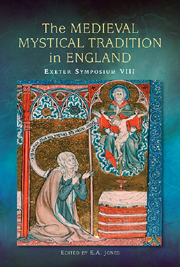 The Medieval Mystical Tradition in England
The Medieval Mystical Tradition in England Published online by Cambridge University Press: 05 July 2013
In the anonymous fourteenth-century poem,The Pricke of Conscience, its author focuses in considerable detail on the miseries of this life, the torments of Hell and Purgatory, and the joys awaiting the saved in Paradise. In Part Four of this text, we are presented with a detailed and theologically informed treatment of the doctrine of Purgatory as it was developing during the later Middle Ages, including details of the ‘payns seven’ (2897) which a soul could expect in Purgatory after death. According to this author, too, the boundaries between this world and the afterlife were permeable, with those left on earth being able to affect the course of a soul's expiation of sin before its triumphant entry into Heaven. Moreover, that soul could, under some circumstances, return to warn the living of what lay in store for them and thus bring about a mutual deliverance:
… thurgh helpe and spede
Of prayer of frendes and alumusdede,
Til wham þai ofte in gast apere,
Thurgh speciel grace, in sere stedes here,
For to hast þair deliverance. (2882-6)
Whilst Jacques Le Goff considered the purgatorial doctrine to have emerged at the end of the twelfth century, more recently, Takami Matsuda has argued that concerns about Purgatory only began to reveal themselves within an English literary context at the end of the thirteenth century, in which case the poem can be regarded as belonging to a new and innovative genre which sought to articulate a type of third space between Heaven and Hell in which a soul could atone for a range of earthly sins.
To save this book to your Kindle, first ensure no-reply@cambridge.org is added to your Approved Personal Document E-mail List under your Personal Document Settings on the Manage Your Content and Devices page of your Amazon account. Then enter the ‘name’ part of your Kindle email address below. Find out more about saving to your Kindle.
Note you can select to save to either the @free.kindle.com or @kindle.com variations. ‘@free.kindle.com’ emails are free but can only be saved to your device when it is connected to wi-fi. ‘@kindle.com’ emails can be delivered even when you are not connected to wi-fi, but note that service fees apply.
Find out more about the Kindle Personal Document Service.
To save content items to your account, please confirm that you agree to abide by our usage policies. If this is the first time you use this feature, you will be asked to authorise Cambridge Core to connect with your account. Find out more about saving content to Dropbox.
To save content items to your account, please confirm that you agree to abide by our usage policies. If this is the first time you use this feature, you will be asked to authorise Cambridge Core to connect with your account. Find out more about saving content to Google Drive.